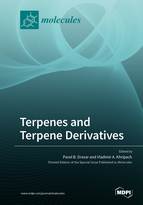Terpenes and Terpene Derivatives
A special issue of Molecules (ISSN 1420-3049). This special issue belongs to the section "Natural Products Chemistry".
Deadline for manuscript submissions: closed (30 October 2020) | Viewed by 61934
Special Issue Editors
Interests: natural product chemistry; synthesis of heterocycles; non-hormonally active steroids; terpenes; supramolecular systems with chiral natural products; fluorescent labelling
Special Issues, Collections and Topics in MDPI journals
Interests: steroids; natural product heterocyclic and pesticide chemistry; synthesis, bioactivity, and practical application of natural bioregulators and their analogs in agriculture and medicine
Special Issues, Collections and Topics in MDPI journals
Special Issue Information
Dear Colleagues,
Terpenes, their derivatives and generally isoprenoids, as natural secondary metabolites, are playing stable and growing roles in human and veterinary medicine, supramolecular chemistry, in food and cosmetic R&D and industry, and in other, increasing numbers of fields. Their importance is based i.a. on the fact that they are mostly bound to renewable sources, which in fact makes them valuable within a circular economy. Terpenes and steroids are also an origin of stereochemistry, regioselectivity, chirality, and many other features and disciplines within science, development, and industry on a scope which is indispensable.
This Special Issue aims to underline current developments in all fields that are connected to terpene research and utilisation and will present a sequel to the successful Special Issue of Molecules "Synthesis, Study and Utilization of Natural Products" to commemorate the heritage of the great terpene scientist, Prof. Kenji Mori, who passed away recently.
Prof. Dr. Pavel B. Drasar
Prof. Dr. Vladimir A. Khripach
Guest Editors
Manuscript Submission Information
Manuscripts should be submitted online at www.mdpi.com by registering and logging in to this website. Once you are registered, click here to go to the submission form. Manuscripts can be submitted until the deadline. All submissions that pass pre-check are peer-reviewed. Accepted papers will be published continuously in the journal (as soon as accepted) and will be listed together on the special issue website. Research articles, review articles as well as short communications are invited. For planned papers, a title and short abstract (about 100 words) can be sent to the Editorial Office for announcement on this website.
Submitted manuscripts should not have been published previously, nor be under consideration for publication elsewhere (except conference proceedings papers). All manuscripts are thoroughly refereed through a single-blind peer-review process. A guide for authors and other relevant information for submission of manuscripts is available on the Instructions for Authors page. Molecules is an international peer-reviewed open access semimonthly journal published by MDPI.
Please visit the Instructions for Authors page before submitting a manuscript. The Article Processing Charge (APC) for publication in this open access journal is 2700 CHF (Swiss Francs). Submitted papers should be well formatted and use good English. Authors may use MDPI's English editing service prior to publication or during author revisions.
Keywords
- terpene chemistry, biochemistry, repurposing, and practical utilization
- terpene derivatives synthesis
- isolation and analysis of terpenes
- terpenes medicinal and cosmetic utilization
- fluorescent labelling, bio-imaging
- any topic with terpenes not mentioned above
- all connected topics








